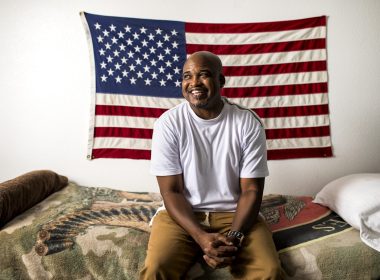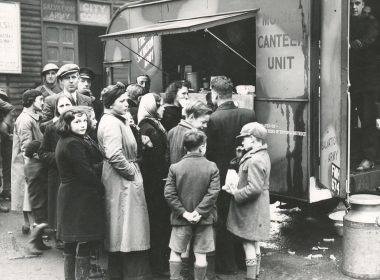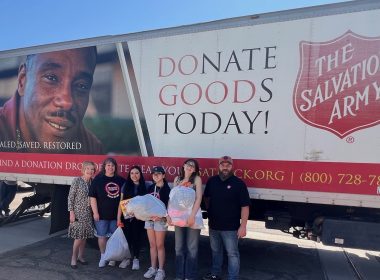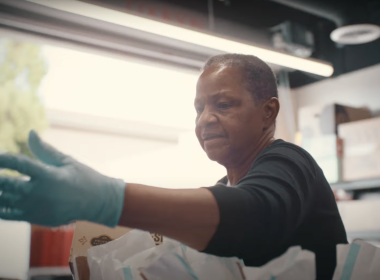 YOUNG PEOPLE WAIT on the sidewalk outside The Way-In shelter in Hollywood. |
BY STEVE ALLEN –
DIRECTOR OF SOCIAL SERVICES
The gap between the rich and the poor in Los Angeles County is an ever-widening one, and it is against this backdrop that The Salvation Army takes a leading role among the private charities and non-profit organizations in setting the pace for effectively addressing the many challenges facing society and the community at large.
Currently, Salvation Army shelters in Los Angeles have up to 1,200 beds available each night, with an additional 330 family placements for transitional living and nearly 70 beds for foster care youth and teenage runaways.
Four licensed child care centers offer more than 400 child care placements to low-income families; a new youth initiative at South Central accesses nine different schools with Salvation Army staff offering tutoring and counseling to 2,000 children; and a family service office, complete with two satellites, serves 15,000 families and individuals on an annual basis. Our main focus is on case management, food and clothing, counseling, accommodation and access to training and employment opportunities.
WELFARE REFORM
The impact of Welfare Reform has already increased the demand upon our family services department by an increase of 15-20%. One of the new initiatives has been the creation of a Job Fair, the most recent taking place in November, 2000. The event was hosted by The Salvation Army, primarily for program participants in its 17 social services programs in Los Angeles County and family service referrals seeking employment.
CalWorks, the Department of Public and Social Services (DPSS), and 41 employers set up booths and met with 475 people. Many clients were hired that day, and others were given the opportunity to meet potential employers, share their resumes and listen to employers talk about what they look for in job candidates.
This event was only one phase of a whole program of re-entry that the Army’s clients participate in as they join the transitional living centers and the rehabilitation programs. Bell Shelter, Santa Fe Springs Transitional Living Center, the new Westwood Transitional Village as well as Harbor Light and Harmony Hall, to name a few of the centers, offer an array of opportunities to help clients become employable and financially self-sufficient. With computer learning centers on site, ESL classes, and local referrals to complete GEDs and vocational training, the Army works to help men and women learn to help themselves.
 THE FIRST HOMELESS court in Los Angeles was held November 19, 2000. Pictured are Steve Allen, Brenda Potts, Safe Harbor graduate, Judge Harry Pregerson and Alex Tostes, Safe Harbor supervisor. |
THE ARMY’S VISION
This has been the Army’s vision long before the federal government came up with the idea of reforming welfare with the Welfare-to-Work Bill in the mid-1990s. William Booth started a match factory in London’s East End and provided many with safe, clean and fair working conditions in the 19th century, while providing a needed product to the economy. Today, programs such as the Bell Shelter (for the homeless) in Los Angeles County have won national recognition and have been the model for The Salvation Army across the nation, as well as for government and other agencies who have followed in our footsteps for the last 100 years in America.
While we must constantly strive for excellence in our program service delivery, we must ensure that the physical, emotional and spiritual needs of the men, women and children we serve are all being met. It has to be said that we have been truly blessed in Los Angeles, to have 600 full-time social work staff, with more than just credentials and experience, but also a passion to reach out and minister to “the lost.”
Never has it been more evident than in places like The Salvation Army’s Harbor Light Center in Los Angeles, a 280-bed drug rehabilitation center, where 45% of its referrals come directly off the street. The Harbor Light has an incredible 67% success rate in terms of men graduating from the program, which translates into more than a thousand men each year, leaving clean and sober. The truth is, however sophisticated the program may have become, the life changing power and love of Jesus Christ is the main reason that both residents and staff give for its success.
 CHILDREN PLAY on the grounds of the Westwood Transitional Housing facility. |
ON-GOING MIRACLES
Here’s one example of the many on-going miracles taking place on Skid Row. It started back on November 21, 1994, at the Harbor Light Center. Donnie Henderson was a member of the Harbor Light staff who really had a heart for the lost–particularly since four years prior to becoming clean and sober, he lived out on the streets of Skid Row. He thanked God on a daily basis for the miracle that had taken place in his own life, for the opportunities that had been afforded to him through the Harbor Light program, and for the gospel of the second chance. Now, as a staff member at the Harbor Light, Donnie often went outside for a breath of (fresh!) air during his break time, and conversed with some of the folks living out on the street. One particular man caught his eye, 53-year-old Adell Ingram.
Donnie spoke with Adell on numerous occasions, telling him how God had changed his life, and how God could do the same for him.
Adell explained, however, that he had been using heroin, cocaine and alcohol for 25 years, he’d been living on the streets for the last three years and that it was too late for him to change. Donnie never gave up, and persisted until November 21, 1994, when Adell agreed to give the Harbor Light program a chance.
Not only did Adell successfully graduate from the program in December, 1995, but he also committed his life to Christ. On January 2, 1996, he commenced work at The Salvation Army Bell Shelter, where he can still be found today as the night supervisor.
Adell says: “My life is now focused on being clean and sober, while trying to help other addicts get their lives together with the help of God.” He has certainly helped many people through the program at Bell Shelter, none more so than his own daughter Debra who at 33-years-old, was also caught up with drugs. She followed her father’s example and successfully graduated from the drug program at Bell Shelter in 1997.
Debra has remained drug free and is now working as a bus driver for the M.T.A. Incidentally, Adell still talks affectionately about a close friend and colleague who works at Bell Shelter as a senior case worker…his name is Donnie Henderson who is also going strong after 10 years!
SALVATION KEY TO SUCCESS
It’s interesting to note that while local government, private agencies and non-profit organizations have often looked to The Salvation Army as an example for social programs that really make an impact, William Booth had it worked out more than 100 years ago when he said: “Socialism will put a new coat on every man, but Jesus Christ will put a new man in every coat.” This is the mission that has been the driving force of The Salvation Army, the salvation of souls, and it is every bit as relevant today in Los Angeles as it was a hundred years ago in London.
The Salvation Army challenges men and women to do more than just look inside themselves for strength and willpower. In a recent challenge to 800 guests at the Social Services Thanksgiving Praise meeting held at the Los Angeles Central Hall, Divisional Commander Lt. Colonel Van Cleef pronounced “Jesus is waiting to forgive you, to heal you and restore you, or you can face him later as judge, remembering the opportunity you passed up tonight to know him as friend.”
The response was tremendous, with 112 program participants lining the altar in order to accept Jesus Christ as their Saviour. Even with so called government restrictions, we are free to access all of our social service programs with a vibrant Christian message. With more than 2,000 clients making first time Christian commitments each year, we must do everything we can in continuing our efforts to maximize our evangelistic opportunities, as our program participants/clients are hungry for the Gospel news!
LOOKING AHEAD
So what can we look forward to in the year 2001?
1. As Los Angeles continues to be the #2 city in the USA for HIV infection, impacting many of those we serve, we continue to be committed to those at risk for infection and those infected. In March of this year, we will be opening up Alegria, the largest Aids Specific program of its type in the USA, accommodating up to 44 families, with a licensed child care facility of 60. On the prevention front, we will be augmenting our HIV prevention services in many of our existing programs.
2. The idea of a Homeless Court is a brand new concept for Los Angeles; The Salvation Army, along with The Honorable Harry Pregerson, who serves as Senior Judge for the United States Court of Appeals in the Ninth Circuit, has played a significant role in bringing this about.
The idea relates to program participants who graduate from a 6-month program clean and sober, and yet face barriers or are precluded from employment because of an outstanding warrant or minor conviction. Upon the recommendation of the executive director and case manager of each program, the judge would have the authority to waive an outstanding warrant or minor conviction, in order to continue the rehabilitation process and allow the client to successfully transition back into the community.
The first-ever Homeless Court in Los Angeles took place on November 19, 2000, at the Union Rescue Mission, and included graduates from the Harbor Light, Safe Harbor and Bell Shelter. We are currently working on the future of this innovative project, with proposed hearings due to take place at The Salvation Army Bell Shelter.
3. With a jail population of 20,000 and an annual “pass through” rate of 160,000 inmates per year, the Los Angeles County jail is working closely with The Salvation Army in targeting veterans and mentally ill inmates, in a bid to reduce the jail population by at least 10%. We have had a number of preliminary meetings with newly-elected Sheriff Lee Baca and Dr. Marvin Southard, Director of Mental Health for L.A. County, which has resulted in a very generous gift of $4 million from county funds generated through AB34 monies, and designated as capital money, targeting the mentally ill.
While we are very much at the embryonic stage, it is our hope in 2001 to expand Bell Shelter from its current 350-bed capacity to approximately 800 beds with 200 beds being specifically targeted for the mentally ill.
4. Booth Memorial caters to 44 pregnant teens and young mothers who are currently in the foster care system at level 12, which is the next level to psychiatric care. Celebrating its 101st anniversary, Booth has recently been successful in establishing its own on-site high school, in addition to its fully licensed child care center.
The year 2001 will see a probable expansion of 12 more beds, the full implementation of a day treatment team, a community based teen service funded under the Department of Education and DPSS in order to offer a mentoring service to high risk youth, and the introduction of the emancipation program for when the girls graduate.
5. The passing of Proposition 36, which will basically divert a large number of drug offenders from the possibility of jail to a range of community-based options, is a great opportunity for The Salvation Army to “step up to the plate.”
Shortly after the passing of the bill, Southern California Division General Secretary Captain Kenneth G. Hodder, along with divisional staff, attended a meeting at Twin Towers County Jail meeting with The Honorable Joseph Tynan who presides over the Proposition 36 funds for Los Angeles.
It was humbling to hear him talk about how he looked to The Salvation Army for leadership in respect of this new venture. (General Wilfred Kitching often used to pray “Lord…please make us half as good as people think we are!”) Needless to say, we have been quick in putting together a comprehensive proposal to Judge Tynan, outlining a number of residential and out-patient treatment programs.
6. Finally and most importantly, we want to be obedient to God’s voice and the prompting of the Holy Spirit. We have been called to seek and to save the lost, but the great commission (Matthew 28:19-20) commands us to go and make disciples of all nations. Our prayer for 2001 is that we will build a greater understanding, and foster even stronger relationships, as we embrace our new brothers and sisters in Christ into our corps and circles of fellowship.
Former National Commander Commissioner Andrew S. Miller (R) once stated: “If you do social work right, and if you do the Gospel right, you can’t tell them apart!”










